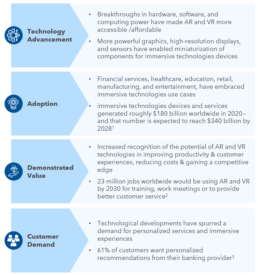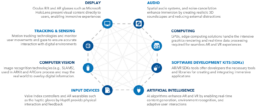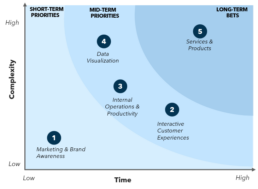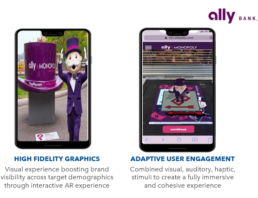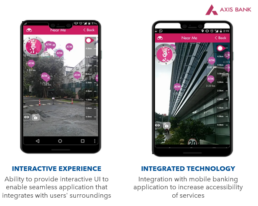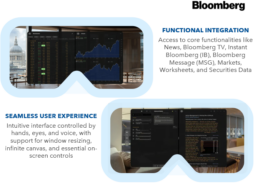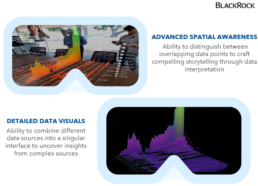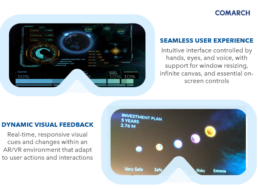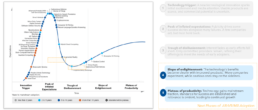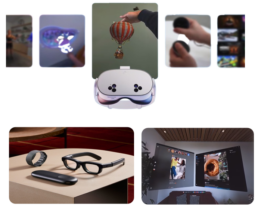The Growth of Mixed Reality
Immersive technologies that allow the user to enter a virtual or augmented reality are no longer a long-term sci-fi reality since leading tech firms (e.g., Nintendo, Microsoft, Meta, Google, Sony) have all released headsets and devices. Beyond gaming and entertainment use cases, immersive technologies provide financial institutions with the tools to boost innovation and competitiveness. While these technologies are not new, they have come to the forefront recently. In the US alone, 65 million AV/VR users, +15% of the country’s population, and over 171 million users worldwide.(1) As these technologies become more accessible to the wider public, AR and VR are expected to grow into a $125 billion market by 2025.(2)
Definitions:
– Virtual reality (VR): Immerses user in a virtual environment
– Augmented reality (AR): Changes the user’s perception of their environment
– Mixed Reality (MR): blend of physical and digital worlds, through intuitive 3D human, computer, and environmental interactions
Exhibit 1. The History
Exhibit 2. Drivers of Growth
The Case for the popularity
The adoption of immersive technologies is pushing the boundaries beyond gaming and entertainment and into new domains. While these technologies are “not ready for prime time” yet, they are already seeing applications in areas like financial services, retail, healthcare, and entertainment. Recent developments in spatial computing are prompting productivity and a new form of computing as the key use cases for immersive technologies. The VR market was forecasted to grow at 45% annually, surpassing $25 billion in revenue by 2024. Virtual reality used within businesses is forecasted to grow from $829 million in 2018 to $4.5 billion in 2024(3)
Adoption is being propelled by the increase in accessibility, demonstrated business value, and popularity/demand among younger generations. Meta is estimated to have sold more than 20 million Quest headsets, mostly the Quest 2 so far, while Apple reportedly moved about 200,000 units of its Apple Vision Pro in pre-sales(4). VR user statistics reveal that just over a quarter (27%) of people aged 25 to 35 (i.e., young Millennials) are planning on buying a VR headset. The next most interested group is Gen Z-ers, of whom nearly a fifth would buy this technology.(5) To stay ahead of the competition, financial services should keep a close pulse on the accelerating adoption of these technologies.
Enabling Technologies
Immersive technologies use technological components to enable immersive experiences that consume the user’s environment and generate an overlay into the physical environment. For example, display technologies for immersive visuals, tracking and sensing systems for accurate user interaction, and computer vision techniques for integrating digital content with the real world.
Exhibit 3. Enabling Technologies
Industry Use Cases
While the complexity of solutions may vary, the potential benefits from immersive technologies use cases in financial services include improved customer engagement, enhanced brand perception, increased productivity, and operational efficiencies
Exhibit 4. Opportunities and Use Cases
1. MARKETING & BRAND AWARENESS
Immersive experiences like virtual investment tours, AR advertising, and VR-based financial literacy are set to transform financial services.
1.a. MasterCard partnered with Wearality to create a VR experience called ‘Priceless’ allowing players to interact with a virtual environment(6)
1.b. Fidelity Labs used Oculus Rift to create an immersive 3D environment to analyze and create ‘Stock City’ to view a 3D reality(7)
1.c. Ally released an AR campaign turning 6 U.S. cities into Monopoly boards to enjoy a Pokemon Go!-style scavenger hunt.(8)
2.INTERACTIVE CUSTOMER EXPERIENCES
From virtual banking branches and financial planning sessions to interactive investment portfolios and AR-enhanced mobile banking apps, immersive interfaces enhance customer satisfaction, brand loyalty, and cross/up-selling.
2.a. WestPac Bank enabled customers to scan their bank cards to get account information (e.g., current balance, spending reports).(9)
2.b. Axis Bank released an augmented reality app that guides customers to the nearest ATMs and bank branches(10).
3.INTERNAL OPERATIONS & PRODUCTIVITY
Immersive technologies enhance internal operations for risk management, compliance monitoring & cybersecurity. From real-time risk visualizations to crisis simulations, these technologies enhance decision-making and operational resilience.
3.a. Bank of America launched VR training for routine & complex tasks, to simulate client interactions through a virtual environment etc.
3.b. Bloomberg launched the Apple Vision Pro App to enable users to bridge the gap between the multiple monitors of traditional desktops.(11)
4.DATA VISUALIZATION
Immersive technologies empower financial professionals with immersive training, real-time data visualization, and virtual collaboration platforms. These tools enhance productivity and streamline workflows.
4.a.Citi launched a Holographic Workstation for Financial Trading using 2D-3D combining voice, gaze, and gesture inputs.(12)
4.b.BlackRock integrated Flow Immersive AR/VR tech that helps combine narrative storytelling with data insights to make better decisions and form robust mental models of information.
5. SERVICES & PRODUCTS
Immersive technologies can also deliver innovative offerings such as virtual reality investment simulations, augmented reality insurance claim processing, and immersive financial education.
5.a. Visa & Blippar launched AR shopping and payment experience for customers to visit stores, select products & pay via the AR App.(13)
5.b. Comarch created a VR investing app combining financial planning and investment advisory into one tool tied in with a smartwatch.(14)
The Future of AR/VR/MR Adoption
It took 25 years for both the internet and Web 1.0 and cell phones to achieve 50% adoption, while social media reached mass adoption in just 14 years. Fortunately, the time required for new technologies to gain widespread acceptance is decreasing, provided that the necessary “enablers” for adoption are in place. While immersive technologies have made great progress, it has still not been able to reach levels of adoption akin to AI, blockchain, and IoT. Today, 7% of the U.S. population uses VR, and 28.1% use AR monthly, but for the technology to become indispensable this percentage needs to reach levels akin to technologies like cell phones or computers.1As with any new technology, there is variability in the hype and delivery on expectations over time.
Exhibit 5. Emerging Technology Hype Cycle
Market Dynamics to Monitor
For AR/VR/MR to reach maximum levels of adoption, there are 5 market dynamics you need to monitor that signal the technology has reached what Gartner calls a “plateau of productivity”. Beyond hype, here is what financial institutions should monitor in the years to come:
A. HARDWARE ADVANCEMENTS: Improvements in hardware devices, and the ability for customers to easily immerse themselves in an altered reality, is the first precursor to adoption. This can be seen via:
1. Decreased Costs: The top barrier to VR adoption is that it’s too expensive, with 55% of respondents listing this as their hesitation.(15) That has spurred innovation, with Meta launching the newest edition of MetaQuest 3S for $299 & dropping the prices of previous models.
2. Improved Capabilities: Users of upgraded smart glasses with features like photo/video capabilities, and voice commands report a 70% increase in daily usage, compared to previous generations that lacked these features(16)
B. USER EXPERIENCE IMPROVEMENTS: The user experience of some large and incompatible headsets that make the user dizzy is still a challenge.
1. Seamless Functionality: Over 60% of consumers are interested in wearing smart glasses that do not compromise style for functionality, highlighting a shift towards more aesthetically pleasing wearables.(17)
2. Improved Applications and Products: Several companies have entered or re-entered the smart glasses market to offer choices for the more style-conscious consumer, including Alphabet and Meta, with products that allow you to take pictures and video, as well as answer phone calls.
Exhibit 6. New MetaQuest3S & Orion (4)
C. INDESPENSIBLE USE CASES:
To ensure widespread adoption, AR/VR need to move beyond niche applications to more practical and impactful use cases. However, the technology must be able to do something the customer cannot already do well, if not better, with existing technologies. The most promising use case is the ability for professionals to work through multi display integration facilitated by sleek hardware devices.
1. Improved Productivity: Immersive technology’s biggest potential use case beyond entertainment hinges on its ability to be a conduit for new ways of working. Companies using AR have reported an average productivity improvement of 32%, as well as a 46% reduction in time to complete tasks, sometimes without even requiring the use of special AR/VR devices but simply using their phones or PCs.(18)
2. Heightened Accessibility: While work-from-anywhere continues to become entrenched as a norm, some industries cannot adapt to a hybrid or remote setup. A sleek device that does not require multiple large-screen displays enables people to work from any where and serves as an alternative to these segments. For example, VR and AR-based working
- Reduce training time by 40% (19)
- Improve employee performance by 70% (19)
- Increase ability to collaborate remotely by 63% (19)
D. CUSTOMER BEHAVIOR SHIFTS:
Demand for immersive experiences and adoption in adjacent industries signals growth in demand for AR/VR and a fertile market for new experiences. Increased consumer interest in interactive and immersive financial experiences by younger generations (Millennials and Gen Z), or adoption by sectors like e-commerce, retail, healthcare, or education can signal readiness for wider adoption in finance.
1.Generational Shifts: Over 50% of Gen Z shows interest in using AR/VR daily compared to 28% of Baby Boomers, suggesting a generational shift towards immersive tech adoption.(20)
E. MARKET MATURITY & INVESTMENTS: Product launches, partnerships, and investment trends signal movement toward technology integration and market maturity. Significant investments in AR/VR by financial institutions, fintech, or big tech players directed toward customer-facing applications, or AR/VR-based products like virtual branch experiences, immersive financial planning, or digital twins for assets signal growth in adoption.
1.Growth in Investments: As of 2023, over 70% of the top 100 companies in the Forbes Global 2000 have explored AR/VR technologies(21) and forecast a $4.1 billion investment into training use of AR/VR/MR.(22) These are clear signs of the accelerated pace of adoption spearheaded by catalysts creating a virtual world.
In Conclusion
While immersive technologies are still maturing, their growth over the next couple of years could open new experiences for financial institutions. Whether it’s used internally for streamlining operational efficiency, or externally to offer clients new services and products, these devices have the capacity to delight customers, provide an early competitive advantage, and improve internal operations.
As with any new solution, implementation has its challenges, mainly related to complexity and the difficulty of delivering a seamless user experience. The proliferation of the technology hinges on the ability to become a platform that is indispensable to customers, facilitating a seamless user experience, and improvements in the underlying technology (e.g., devices)
Once technology reaches the level of becoming ubiquitous in our lives, it can become a platform for financial services to explore new frontiers of growth. To capitalize on this potential, financial institutions should keep a pulse on market developments and adopt a strategic approach to investment in hardware & software, targeted development of practical applications, and overcoming existing barriers.
- Zipia
- Business Wire
- CNBC
- SBJ
- DataProt
- Bigoh Tech
- Alley Watch
- Blue Label
- Blue Label
- Blue Label
- Bloomberg
- The Financia Brand
- Insider Intelligence
- Gartner
- Insider Intelligence
- Nielsen
- IDC
- Company Newsroom
- Insider Intelligence
- Gartner
- Forbes

